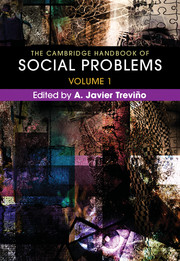Book contents
- The Cambridge Handbook of Social Problems
- The Cambridge Handbook of Social Problems
- Copyright page
- Contents
- About the Contributors
- Introduction
- Part I General Concerns and Orientations in the Study of Social Problems
- Part II Historical and Theoretical Issues in the Study of Social Problems
- Part III Problems of Discrimination and Inequality
- Part IV Problems of Institutions
- Index
- References
Part IV - Problems of Institutions
Published online by Cambridge University Press: 16 March 2018
- The Cambridge Handbook of Social Problems
- The Cambridge Handbook of Social Problems
- Copyright page
- Contents
- About the Contributors
- Introduction
- Part I General Concerns and Orientations in the Study of Social Problems
- Part II Historical and Theoretical Issues in the Study of Social Problems
- Part III Problems of Discrimination and Inequality
- Part IV Problems of Institutions
- Index
- References
Summary
Media are central actors in the social construction of social problems. The volume of media publicity can shape whether citizens perceive an issue as worthy of public discussion and potential policy action. Media are a primary arena where social problems advocates direct their efforts to influence public understanding of prospective social problems. In addition, from the early years of film through contemporary debates about video games, social science research has long examined competing arguments about the role of media as a potential cause of social problems. With the developing of new forms of digital and social media, new concerns about media-related social problems are emerging, including those focused on electronic surveillance and the digital divide.
Information
- Type
- Chapter
- Information
- The Cambridge Handbook of Social Problems , pp. 475 - 566Publisher: Cambridge University PressPrint publication year: 2018
